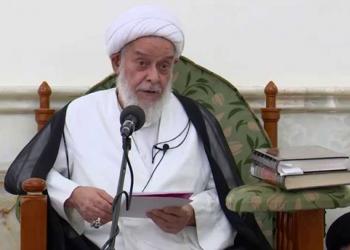
RNA – Speaking to a number of missionaries and lecturers of the Islamic Seminary of Najaf, Ayatollah Hadi Aale-Radhi, a senior professor in the seminary, said, “The purpose of the seminary courses is to teach and guide the people [in regard to religious teachings]. On this basis, the pilgrimage of Arba’in al-Husayni is an appropriate opportunity for the seminary students who engage in their duties to spread Islamic teachings and guidance.”
The Iraqi cleric added, “The participation of millions of pilgrims in the pilgrimage of Arba’in al-Husayni, their annual increase and the absence of any incident on this route is a divine act.”
Ayatollah Aale-Radhi stated, “If we compare the ceremonies of Arba’in al-Husayni with the Hajj pilgrimage, we clearly see the existence of hidden hands in this issue. The government and Hajj organizations spend a lot of money in order to provide tranquility for the pilgrims during the Hajj pilgrimage and yet we hear and see that there many events occurred during those days and that the Hajj pilgrims were not satisfied with the lack of proper facilities, but in opposition. we hear only a very small number of complaints and problems in regard to the commemoration of Arba’in al-Husayni.”
The teacher in the Islamic Seminary of Najaf emphasized that pilgrims and missionaries should present the real and sacred face of this great pilgrimage to the world.
It should be noted that Arba’in, meaning “forty” is a Shi’ah Muslim religious observance that occurs forty days after the Day of Ashura. It commemorates the martyrdom of Imam al-Husayn ibn Ali, the grandson of the Prophet Muhammad, who was killed on the tenth day of the month of Muharram alongside 72 of his companions by the tyrannical caliph Yazid I’s army in the Battle of Karbala in 61 AH (680 CE).
During the days leading up to Arba’in, millions of pilgrims throughout the Islamic world walk to the city of Karbala, where Imam al-Husayn and his companions are buried, from Najaf, another holy city in Iraq, to show their devotion. The two cities are more than 75 kilometres apart.
In 2016, 27 million people from various countries participated in the Arba’in pilgrimage in the Iraqi city of Karbala while only 2.35 million people attended the Hajj pilgrimage in Makkah, Saudi Arabia. This is while Iraq is suffering from the effects of years of war, poverty and the threat of Takfiri terrorism.
Arba’in is considered a direct challenge to Saudi Arabia, which has been slammed by Iran for its mismanagement of the hajj, given the deadly stampede in 2015 that led to the deaths of a large number of pilgrims – including hundreds of Iranians.
Management of the pilgrimage in Iraq has nothing to do with the government, and the price of the trip is cheap, as a lot of volunteers on the path of the march to Karbala give free food and drinks to pilgrims. Plus, no one has been killed due to a stampede or any sort of mismanagement.
This year, the day of Arba’in will fall on November 9th and on this day, the pilgrims will converge on the city of Karbala and make a pilgrimage to the holy shrines of Imam al-Husayn, his brother Abbas ibn Ali, and his companions.